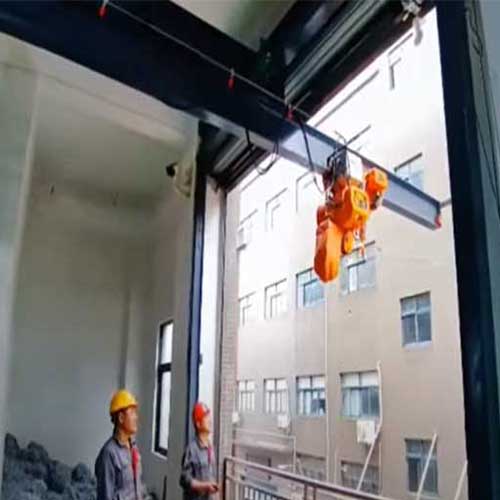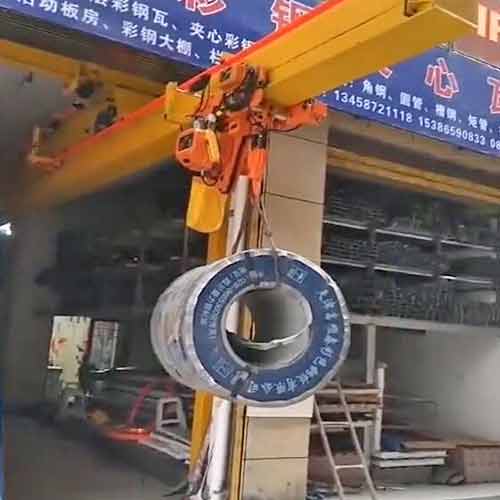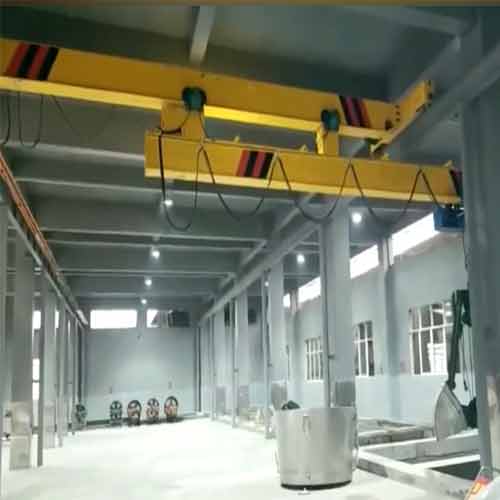Your Trusted Telescopic Cranes and Telescoping Crane Manufacturer & Supplier
Telescopic Cranes for Sale, Versatile Telescoping Cranes Solutions for Lifting Needs
From Workshops to High Rises: Telescopic Cranes for Higher Vertical Lifing Height & Prolongeed Horizontal Rich
Telescopic cranes, also known as telescoping cranes, provide flexible lifting solutions. Their extendable designs enhance reach and efficiency across various applications.
Telescopic cranes, also known as telescoping cranes, are highly adaptable lifting machines that feature an extendable boom designed to reach various heights and distances. This versatility makes them essential tools in a range of applications across different industries. The ability to adjust the boom allows these cranes to effectively handle loads in confined spaces or over obstacles, enhancing their utility.
Advantages of Telescoping Design
The telescoping design offers several important advantages:
- Increased Reach: The crane can extend its boom to lift loads high or move them across long distances.
- Compact Storage: When not in use, telescopic cranes can be retracted to a smaller size, making them easier to transport and store.
- Operational Flexibility: Their ability to adapt to different tasks makes them suitable for various industries.
Types of Telescopic Cranes
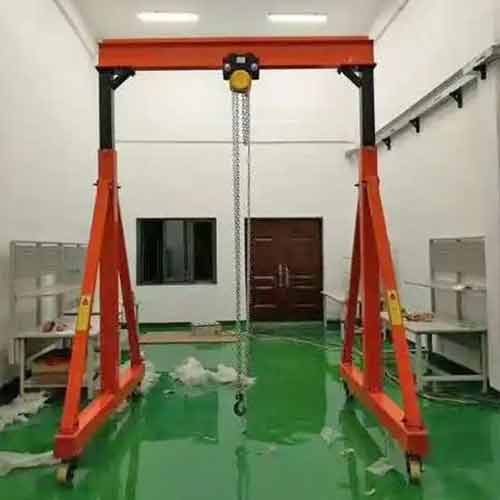
Telescopic Gantry Crane (Telescoping Gantry Crane)
Overview of Telescopic Gantry Cranes
Telescopic gantry cranes, known for their adaptability and mobility, are essential tools in various industrial settings. Their design allows for easy adjustments in height and span, making them suitable for a wide range of lifting tasks.
Typical Features
- Adjustable Height and Span: Telescopic gantry cranes can be easily adjusted in both height and span to accommodate various lifting needs. This flexibility allows them to be tailored for specific tasks, ensuring optimal performance.
- Mobility Options (Manual or Motorized): These cranes can come with manual wheels for easy movement or motorized options for automated travel, enhancing usability in different environments.
- Robust Frame for Stability: Built with a strong and durable frame, telescopic gantry cranes provide stability during lifting operations, minimizing the risk of tipping or shifting when handling loads.
Typical Applications
- Workshop and Factory Environments: Often used in workshops for assembling machinery, conducting maintenance tasks, or moving heavy components, these cranes are designed to operate effectively in confined spaces.
- Outdoor Construction Sites: Their mobility and adjustable features make telescopic gantry cranes ideal for various tasks at construction sites, from lifting heavy materials to positioning equipment.
Typical Loads Handling: Commonly Handles Loads Between 1 Ton to 2 Tons: These cranes are well-suited for light to moderate lifting tasks, making them versatile tools for many industrial applications.
1 Ton Telescoping Gantry Crane
Compact Design, Adjustable Height: The 1-ton telescoping gantry crane is designed with a compact structure, allowing it to maneuver easily in confined spaces. Its adjustable height feature enables it to tackle various small-scale tasks effectively, making it a versatile tool for operations that require flexibility.
Recommended Applications
- Small-Scale Assembly Tasks: This crane is ideal for lifting components in small workshops, facilitating the assembly of parts with ease and precision.
- Maintenance Work: It is perfect for maintenance areas, where it can efficiently lift and position equipment or materials for repair tasks.
2 Ton Telescoping Gantry Crane
Enhanced Lifting Capacity, Versatile Mobility: The 2-ton telescoping gantry crane provides a higher lifting capacity while still maintaining excellent mobility. It can be fitted with wheels for easy relocation or equipped with fixed stands for stable operation during lifting tasks.
Recommended Applications
- Medium-Duty Lifting in Warehouses: This crane is well-suited for handling heavier loads in warehouse environments, where it can be used to transport and position goods effectively.
- Manufacturing Facilities: Its robust design makes it ideal for moving materials and components within manufacturing plants, improving workflow and efficiency.
In summary, telescopic gantry cranes, including the 1-ton and 2-ton models, offer flexible lifting solutions tailored for a variety of tasks. Their adjustable features and sturdy construction make them essential tools in workshops, construction sites, and manufacturing facilities, capable of meeting diverse lifting needs with ease.
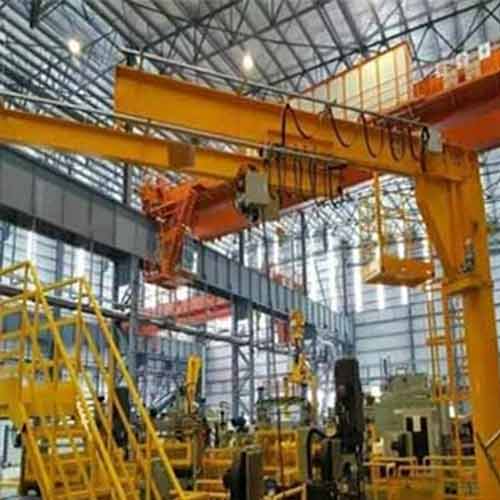
Telescopic Jib Crane (Telescoping Jib Crane)
Overview of Telescopic Jib Cranes
Telescopic jib cranes are designed for versatility and precision, making them essential tools in various industrial environments. Their innovative design enhances both reach and maneuverability, allowing for efficient material handling.
Typical Features
- Articulating Arm Design for Extended Reach: The crane's arm can extend beyond traditional fixed structures, providing increased flexibility to reach out and lift materials effectively.
- Rotational Capabilities: Many models come equipped with rotational functions, enabling smooth movement and precise placement of loads within a defined workspace.
Typical Applications
- Assembly Lines: Extensively utilized in manufacturing settings for positioning components and materials accurately.
- Loading Docks: Ideal for quick and efficient loading and unloading of goods, enhancing operational efficiency.
Typical Loads Handling
- Commonly Handles Loads from 500 kg to 1 Ton: These cranes are specifically designed for moderate lifting tasks, balancing strength and precision for optimal performance.
500 Ton Telescoping Jib Crane
Heavy-Duty Construction: This crane is built with robust materials to support high load capacities, making it suitable for demanding industrial applications.
Recommended Applications
- Heavy Industrial Tasks: Perfect for use in environments such as manufacturing plants and shipyards, where substantial lifting power is essential for operations.
1 Ton Telescoping Jib Crane
Lightweight Design: Constructed from lightweight materials, this crane is easy to adjust in height and reach, which enhances usability in various tasks.
Recommended Applications
- Warehouse Lifting: Ideal for operations in warehouses that require quick and efficient lifting solutions, facilitating smooth workflows.
- Small Manufacturing Processes: Well-suited for light manufacturing tasks where flexibility and precision are crucial for productivity.
In conclusion, telescopic jib cranes merge advanced design with practical features, enabling them to execute a wide range of lifting tasks across different industries. Their adaptability to various load capacities and environments makes them vital assets in both light and heavy-duty applications, enhancing efficiency and effectiveness in material handling.
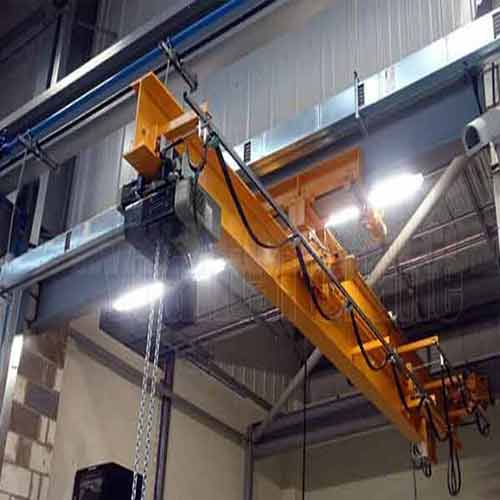
Telescopic Bridge Crane (Telescoping Bridge Crane)
Overview of Telescopic Bridge Cranes
Telescopic bridge cranes are specialized lifting solutions designed to boost efficiency and productivity in expansive workspaces. Their unique structure allows for extended reach and versatile operation, making them suitable for a wide range of applications.
Typical Features
- Extendable Cantilever for Increased Reach: The extendable cantilever design enables these cranes to reach across larger areas, providing flexibility in positioning and lifting materials effectively.
- Overhead Rail Systems for Smooth Operation: Equipped with overhead rail systems, telescopic bridge cranes ensure smooth travel along defined paths, enhancing operational efficiency during lifting tasks.
Typical Applications
- Large Manufacturing Facilities: Ideal for extensive production environments where heavy lifting is required, facilitating the movement of materials and components efficiently.
- Assembly Plants: Frequently used in assembly operations, these cranes enable seamless movement of parts and materials, streamlining production processes.
Typical Loads Handling
- Commonly Handles Loads from 1 Ton to 2 Tons: Telescopic bridge cranes are designed to manage moderate loads, providing a balance of strength and versatility for various lifting tasks.
1 Ton Telescoping Bridge Crane
Space-Efficient Design: The 1-ton telescoping bridge crane features a compact structure that optimizes space, making it suitable for areas with limited overhead clearance.
Smooth Operation: Engineered for quiet and efficient performance, this crane allows for precise lifting and movement of materials, ensuring effective handling without unnecessary noise.
Recommended Applications
- Precision Tasks in Confined Spaces: This crane is perfect for operations that require meticulous handling of materials in tight or restricted environments, such as small workshops or assembly lines, enhancing workflow efficiency.
2 Ton Telescoping Bridge Crane
Enhanced Stability and Durability: The 2-ton model offers improved stability, making it ideal for handling heavier loads with confidence, reducing the risk of accidents during lifting.
Robust Construction: Built to withstand rigorous use, this crane features durable materials that ensure long-lasting performance, making it a reliable choice for demanding industrial applications.
Recommended Applications
- Heavy Lifting in Larger Workshops and Factories: This crane is designed for substantial lifting tasks in larger workspaces, providing the strength needed for efficiently moving bulky or heavy items, improving productivity in various operations.
In summary, telescopic bridge cranes are essential tools in large-scale manufacturing and assembly environments. Their extendable design and robust features make them ideal for handling a variety of loads, enhancing productivity and operational efficiency across diverse industrial applications
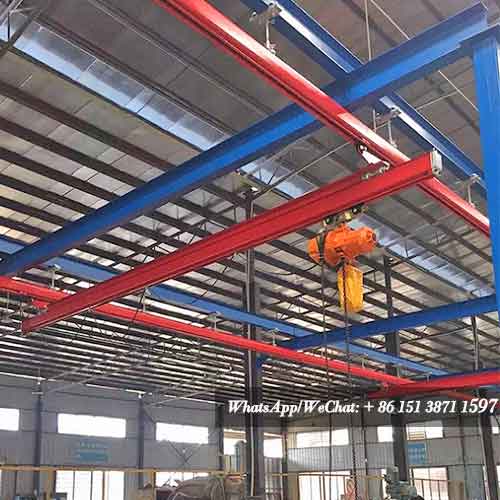
KBK Extendable Crane (Small Telescopic Crane)
Overview of KBK Extendable Cranes
KBK extendable cranes, commonly known as small telescopic cranes, are designed for flexibility and efficiency in lighter industrial tasks. Their modular construction allows for easy customization to meet specific lifting needs, making them a practical choice for various applications.
Typical Features
- Modular Design for Customization: These cranes feature a modular design that enables users to configure them based on their workspace and lifting requirements, ensuring optimal use of available space and resources.
- Lightweight and Portable: Constructed from lightweight materials, KBK extendable cranes are easy to transport and reposition, making them ideal for dynamic work environments where mobility is essential.
Typical Applications
- Light Industrial Work: Commonly utilized in settings such as workshops and small factories, these cranes efficiently move lighter loads, enhancing operational workflows.
- Smaller Production Lines: They are perfect for production lines that require quick and efficient material handling without the need for heavy-duty equipment, promoting productivity in various tasks.
Typical Loads Handling
- Commonly Handles Loads from 500 kg to 1 Ton: KBK extendable cranes are well-suited for light lifting tasks, providing sufficient capacity for everyday industrial operations while ensuring safety and reliability.
500 kg KBK Extendable Crane
Compact, Easy to Install: The 500 kg model boasts a compact footprint, making it easy to install and integrate into existing setups without extensive modifications or disruptions to ongoing operations.
Recommended Applications
- Small Workshops, Limited Space Environments: This crane is ideal for operations in small workshops where space is at a premium. It allows for effective lifting and material handling without compromising performance or efficiency.
1 Ton KBK Extendable Crane
Increased Capacity, Versatile Design: The 1-ton KBK extendable crane offers greater lifting capacity while maintaining a versatile design that adapts to various tasks and environments, making it a flexible option for different industrial needs.
Recommended Applications:
- Assembly Work, Light Manufacturing Processes: This crane is well-suited for assembly tasks and light manufacturing processes, providing the strength needed to handle components efficiently and reliably in diverse settings.
In conclusion, KBK extendable cranes are excellent solutions for light lifting in compact spaces. Their modular and portable design, combined with their ability to handle loads up to 1 ton, makes them invaluable in many light industrial applications. These cranes ensure productivity and ease of use in diverse environments, enhancing operational efficiency and flexibility.
Applications of Telescopic Cranes: Enhancing Lifting Height and Horizontal Reach
Telescopic cranes are engineered to extend both vertically and horizontally, making them invaluable for various material handling tasks across multiple industries. Their unique design provides flexibility in lifting and positioning materials in challenging environments.
Telescopic Crane with Extended Lifting Height
Applications
Telescopic cranes with extended lifting height are specifically designed to meet the demands of material handling tasks in workshops and industrial facilities. Their ability to reach significant vertical heights enables efficient handling of a wide range of items.
Key Features and Benefits
- Adjustable Height Mechanism: These cranes typically feature hydraulic or mechanical systems that allow operators to adjust the lifting height according to task requirements. This adaptability ensures optimal performance, whether lifting light materials or heavier loads.
- Enhanced Stability: Many telescopic cranes come with a stable base to reduce the risk of tipping during operation. This feature is crucial for safely lifting materials to significant heights, protecting both the operator and surrounding personnel.
- Easy Operation: With user-friendly controls, these cranes allow operators to manage lifting tasks efficiently, enhancing workplace productivity. Some models include remote control options for added convenience.
Typical Applications in Workshops and Facilities
- Maintenance and Repair Tasks: In industrial settings, telescopic cranes are essential for accessing machinery and equipment at height. They can lift tools and replacement parts, facilitating maintenance activities without the need for scaffolding.
- Inventory Management: Workshops often require lifting and repositioning heavy materials, such as metal sheets and machinery components. Telescopic cranes can efficiently handle these tasks, simplifying inventory organization and management.
- Assembly Line Operations: In manufacturing environments, these cranes assist in assembling components at various heights. Their adjustable lifting capabilities allow seamless integration into assembly workflows.
- Installation of Equipment: Telescopic cranes are ideal for installing heavy equipment or fixtures that need to be positioned at elevated locations, such as air conditioning units, ventilation systems, or lighting fixtures.
- Material Transport Between Levels: In multi-story facilities, these cranes facilitate vertical transport of materials between floors, particularly useful in warehouses and distribution centers where goods need to be moved efficiently.
Telescopic cranes with extended lifting heights play a critical role in enhancing operational efficiency in workshops and industrial facilities. Their precise vertical transport capabilities streamline processes, ensuring safety and productivity, making them essential assets in modern material handling operations.
Telescopic Crane with Extended or Sliding Cantilever for Prolonged Horizontal Reach
Applications
- Material Handling Beyond Main Girders: Telescopic cranes can position materials beyond a structure's main girders, allowing for precise placement in tight spaces or areas with obstacles.
- High Building Material Handling: These cranes excel at lifting materials to significant heights on construction sites, handling everything from steel beams to concrete panels and roofing materials.
- Window and Façade Work: Telescopic cranes can extend out of windows or over building edges, facilitating the installation of façade elements, windows, and HVAC systems without requiring scaffolding.
- Accessing Difficult Areas: Their horizontal extension capability enables cranes to place materials behind columns, doors, or walls, which is particularly beneficial in warehouses and manufacturing plants with limited space.
Practical Applications Across Industries
- Construction: In high-rise building projects, telescopic cranes are essential for transporting materials to upper floors, handling everything from steel reinforcement to large construction equipment.
- Manufacturing: In factories, these cranes efficiently move parts and materials across large production areas, facilitating smooth workflows.
- Maintenance: For maintenance tasks in industrial facilities, telescopic cranes can access hard-to-reach areas, enabling repair and replacement of equipment or structural elements.
Benefits of Using Telescopic Cranes
Versatility
Telescopic cranes are engineered to tackle a diverse range of lifting tasks, making them invaluable in multiple industries.
- Adaptability: These cranes can handle various load capacities, from light materials to heavy industrial components, ensuring they meet the specific requirements of different applications.
- Industry Applications: Commonly used in construction for lifting steel beams, in manufacturing for moving components along assembly lines, and in logistics for managing heavy shipping containers.
Efficiency
The design of telescopic cranes allows for rapid adjustments in both height and horizontal reach, which contributes significantly to operational efficiency.
- Quick Setup: The ability to extend and retract quickly minimizes setup time compared to traditional cranes.
- Reduced Downtime: Their multifunctional capabilities mean fewer delays, as one crane can perform multiple tasks, leading to a more streamlined workflow.
- Enhanced Productivity: Operators can complete tasks more swiftly, improving overall site productivity and allowing for faster project completion.
Space-Saving
Telescopic cranes have a compact footprint, which makes them particularly effective in constrained environments.
- Ideal for Urban Settings: Their ability to operate in tight spaces makes them perfect for urban construction projects where space is limited.
- Flexible Maneuverability: These cranes can navigate narrow aisles and confined areas, allowing for efficient material handling without the need for extensive ground space.
- Reduced Site Preparation: The smaller operational area can lead to lower costs in site preparation and logistics.
Safety
Safety is a paramount concern in any lifting operation, and telescopic cranes often come equipped with advanced safety features.
- Overload Protection: Many models include sensors that prevent the crane from lifting loads beyond its capacity, reducing the risk of accidents.
- Stability Controls: These cranes are designed with a stable base to minimize the chance of tipping over, even when lifting heavy materials to great heights.
- User-Friendly Controls: Intuitive controls enhance operator confidence, ensuring safer operation, especially in complex environments.
Cost-Effectiveness
The operational advantages of telescopic cranes can translate into significant cost savings for businesses.
- Lower Equipment Needs: The multifunctionality of telescopic cranes reduces the necessity for additional lifting equipment, which can cut down on rental or purchase costs.
- Decreased Operational Downtime: With faster setup and operational capabilities, projects can progress more smoothly, minimizing delays and associated costs.
- Higher Return on Investment: Their versatility and efficiency allow businesses to maximize their investment, making telescopic cranes a financially savvy choice for material handling.
How to Select the Right Telescopic Crane for Your Needs
Selecting the appropriate telescopic crane involves several key considerations to ensure it meets your specific requirements. Here are the factors to consider:
Load Capacity
- Determine Maximum Load: Assess the maximum weight of the materials you will be lifting. Choose a crane with a load capacity that exceeds your heaviest expected load to ensure safety and efficiency.
- Consider Dynamic Loads: Keep in mind not just static loads, but also dynamic loads that may occur during lifting or movement.
Lifting Height and Reach
- Assess Required Height: Evaluate the vertical height you need the crane to reach. Consider the structure of your workspace, including ceilings and other obstacles.
- Horizontal Reach: Determine how far the crane needs to extend horizontally. This is crucial for tasks that require placing materials beyond structural elements like walls or girders.
Space Constraints
- Work Environment: Measure the available space where the crane will operate. Ensure there's enough room for maneuvering and positioning the crane effectively.
- Compact Design: If space is limited, consider models designed for tight environments that maintain efficiency without requiring excessive ground space.
Mobility and Portability
- Wheeled vs. Fixed Cranes: Decide if you need a mobile crane that can be easily relocated or a fixed crane for more permanent installations. Mobile options offer flexibility, while fixed models can provide more stability for heavier loads.
- Weight and Setup: Consider the crane's weight and ease of setup. Lighter models may be more portable and quicker to deploy.
Application Type
- Industry-Specific Needs: Identify the specific tasks the crane will perform, such as construction, manufacturing, or maintenance. Different applications may require specialized features.
- Environmental Conditions: Consider whether the crane will be used indoors, outdoors, or in harsh conditions. Some models may offer enhanced durability or weather resistance.
Safety Features
- Built-in Safety Mechanisms: Look for cranes equipped with safety features such as overload protection, stability controls, and emergency stop functions to protect operators and materials.
- Operator Training: Ensure that operators are trained on the specific crane model and its safety protocols.
Cost Considerations
- Budget: Establish a budget that includes not only the initial purchase cost but also ongoing maintenance, operation, and potential upgrades.
- Long-term Investment: Consider the crane's durability and efficiency, which can lead to lower operational costs and better ROI over time.
Consult Experts
- Manufacturer Recommendations: Seek advice from crane manufacturers or suppliers, who can provide insights based on your specific needs and applications.
- Customer Reviews: Research user experiences and reviews to understand how different models perform in real-world situations.
Selecting the right telescopic crane requires a thorough assessment of your specific needs, including load capacity, lifting height, and workspace constraints. By considering these factors and consulting with experts, you can choose a telescopic crane that enhances efficiency and meets the demands of your operations.
Conclusion: Contact to Get Your Customized Telescoping Crane Design
In summary, telescopic cranes, including telescopic gantry cranes, jib cranes, bridge cranes, and KBK extendable cranes, play a vital role in various industrial applications. Each type of telescopic crane offers distinct features tailored to specific tasks, such as adjustable heights, extendable arms, and modular designs. These cranes are commonly used in workshops, manufacturing facilities, and construction sites, handling loads ranging from 500 kg to 500 tons, depending on the crane type. Their versatility and efficiency make them indispensable tools in modern industry.
Telescopic cranes are increasingly important in modern industries, supporting a wide range of operations from construction to manufacturing. Their ability to efficiently lift and move materials in confined spaces not only boosts productivity but also enhances safety. As businesses strive for greater efficiency and sustainability, telescopic cranes will undoubtedly play a crucial role in shaping the future of material handling. Their ongoing development and adaptation to meet the needs of various sectors underscore their significance in advancing industrial capabilities.
